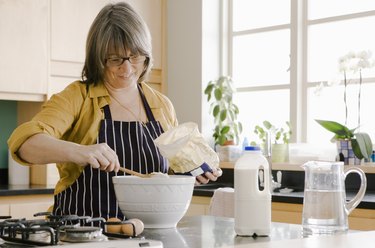Things You'll Need
Gluten-free bread recipe
Ceramic or glass bowl, 1 quart or larger
Plastic spoon
Measuring cups
1 1/2 cups gluten-free flour such as millet, rice, tapioca, sorghum, fava bean or garbanzo bean flour
1 1/2 cups water
Cotton cloth

According to Paul Pitchford in his book, "Healing with Whole Foods," baking yeast is linked to digestive disturbances and yeast overgrowth throughout the body. However, sourdough has been used for thousands of years and increases the health benefits of bread. The fermenting process in sourdough proofing breaks down cellulose, releasing valuable nutrients from the flour. The flora in sourdough also contains lactobacillus, one of the beneficial bacteria that improve digestion. Making sourdough starter with gluten-free flour works similarly to wheat sourdough starters. To make gluten-free sourdough bread, prepare the sourdough starter in advance and substitute it into your favorite gluten-free bread recipe.
Step 1
Make the sourdough starter several days before the bread is to be made. Mix 1 cup of gluten-free flour with 1 cup of water in a plastic or glass bowl. Stir thoroughly with a plastic spoon.
Video of the Day
Step 2
Cover the bowl with a cotton cloth. Place the bowl in a warm place to let the fermenting process begin. The starter will bubble and grow in size over the next few days.
Step 3
Stir the starter every 12 hours. This allows even and continuous growth of flora throughout the starter.
Step 4
Feed the starter once a day. This takes just a minute of time and is necessary to continue the growth of the sourdough flora. Remove 1/2 cup of starter and replace with 1/4 cup gluten-free flour and 1/4 cup water. Mix well.
Step 5
Check the starter after the first two days. If the starter smells sour and has gone through a rise and fall, where it becomes bubbly, doubles in size and falls again, it is ready for use. You can also now store it in the refrigerator.
Step 6
Use the sourdough starter in your favorite gluten-free bread recipe. Sourdough starter can be converted into a yeast bread by replacing the yeast with 1 cup of starter. Reduce 1/2 cup liquid and 1/2 cup of flour from the original recipe. All other steps of the recipe can be followed without alteration.
Step 7
Be prepared to increase the rising time. Sourdough rises slower than yeast and may even take twice as long. Keep the dough in a warm place to decrease rise time.
Tip
Depending on the consistency of the dough, you may need to add back a small amount of flour or water. Working with sourdough can be challenging. Try a different location for your starter if it is not growing well. You can feed your starter once a week, if you are storing it in the refrigerator.
Warning
Do not use your starter if it appears to have grown mold on the surface. Avoid using metal when stirring or storing your starter. Metal reduces fermentation.
Video of the Day